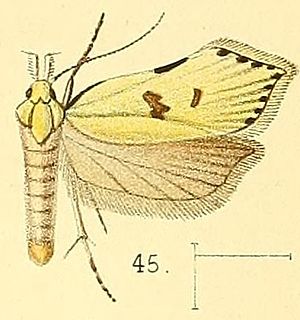Related Research Articles
Epermenia imperialella is a moth in the family Epermeniidae. It was described by August Busck in 1906. It is found in North America, where it has been recorded from Manitoba, Alberta, Iowa and Pennsylvania.
Dichomeris condaliavorella is a moth in the family Gelechiidae. It was described by August Busck in 1900. It is found in North America, where it has been recorded from Florida.
Dichomeris vacciniella is a moth in the family Gelechiidae. It was described by August Busck in 1915. It is found in North America, where it has been recorded from Nova Scotia, southern Quebec and southern Ontario to Florida, Michigan, Missouri and Arkansas.
Dichomeris simpliciella is a moth in the family Gelechiidae. It was described by August Busck in 1904. It is found in North America, where it has been recorded from southern Alberta to Texas, eastern Washington, south-eastern Nevada and Arizona. It has also been recorded from northern Mexico.
Dichomeris leuconotella is a moth in the family Gelechiidae. It was described by August Busck in 1904. It is found in North America, where it has been recorded from Nova Scotia to Maryland, southern Canada, Washington, Colorado, Iowa and Indiana. The habitat consists of open fields.
Dichomeris syringota is a moth in the family Gelechiidae. It was described by Edward Meyrick in 1926. It is found in Peru.
Dichomeris procyphodes is a moth in the family Gelechiidae. It was described by Edward Meyrick in 1922. It is found in Amazonas, Brazil.
Dichomeris condylodes is a moth in the family Gelechiidae. It was described by Edward Meyrick in 1921. It is found in Zimbabwe.
Dichomeris argentaria is a species of moth in the family Gelechiidae. It was described by Edward Meyrick in 1913. It is found in Mpumalanga, South Africa.
Dichomeris cotifera is a moth in the family Gelechiidae. It was described by Edward Meyrick in 1913. It is found in Mpumalanga, South Africa.
Dichomeris costalis is a moth in the family Gelechiidae. It was described by August Busck in 1914. It is found in Panama.
Dichomeris excavata is a moth in the family Gelechiidae. It was described by August Busck in 1914. It is found in Panama.

Dichomeris fracticostella is a moth in the family Gelechiidae. It was described by Walsingham in 1891. It is found in Ghana and Gambia.
Dichomeris varronia is a moth in the family Gelechiidae. It was described by August Busck in 1913. It is found in Panama and Guyana.
Anthistarcha geniatella is a moth in the family Gelechiidae. It was described by August Busck in 1914. It is found in Panama.
Prolita barnesiella is a moth of the family Gelechiidae. It was described by August Busck in 1903. It is found in North America, where it has been recorded from California, Colorado, Arizona, New Mexico, Texas, Wyoming and Utah.
Gnorimoschema florella is a moth in the family Gelechiidae. It was described by August Busck in 1903. It is found in North America, where it has been recorded from Colorado and California.
Battaristis cyclella is a moth of the family Gelechiidae. It was described by August Busck in 1903. It is found in North America, where it has been recorded from Arizona and Utah.
Anacampsis kearfottella is a moth of the family Gelechiidae. It was described by August Busck in 1903. It is found in North America, where it has been recorded in Kentucky, Pennsylvania and New Jersey.
Hamadera aurea is a moth in the family Depressariidae, and the only species in the genus Hamadera. It was described by August Busck in 1914 and is found in Panama.
References
- ↑ Moth Photographers Group
- ↑ Beccaloni, G.; Scoble, M.; Kitching, I.; Simonsen, T.; Robinson, G.; Pitkin, B.; Hine, A.; Lyal, C., eds. (2003). "Dichomeris barnesiella". The Global Lepidoptera Names Index . Natural History Museum . Retrieved May 18, 2018.
- ↑ "Dichomeris Hübner, 1818" at Markku Savela's Lepidoptera and Some Other Life Forms. Retrieved July 7, 2017.
- ↑ Busck, A., 1907. New American Tineina. Proceedings of the Entomological Society of Washington 8(3-4): 92
- ↑ Bug Guide
| This article on a moth of genus Dichomeris is a stub. You can help Wikipedia by expanding it. |